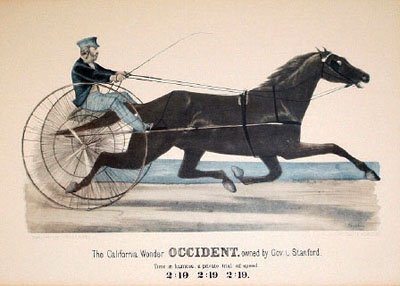Long before Julia Roberts and Brad Pitt hit Hollywood, an
athlete named Occident gained fame as the world’s first
”
movie star.
”
He acted in a short motion picture you’ve mostly likely seen but
probably never knew was made right here in the South Bay region 130
years ago.
Long before Julia Roberts and Brad Pitt hit Hollywood, an athlete named Occident gained fame as the world’s first “movie star.” He acted in a short motion picture you’ve mostly likely seen but probably never knew was made right here in the South Bay region 130 years ago.
With his long nose, pointy ears and flies buzzing around him, Occident wasn’t exactly a matinee idol. But he was an athlete. A racehorse, as a matter of fact. His owner, railroad baron and former California Governor Leland Stanford, picked Occident to perform in the world’s first moving picture.
The 24 frames of this experimental flick showing Occident trotting gracefully was shot at Stanford’s horse farm training track. You’ll find near that Red Barn location (now belonging to Stanford University) various information displays detailing the famous motion picture experiment.
I’m bringing up Occident and motion picture history because Morgan Hill’s annual Poppy Jasper Film Festival takes place Nov. 13-15. I once proposed to the film festival’s organizers my sponsoring a $1,000 prize to be presented to an independent filmmaker for technical innovation. I wanted to call this prize “The Eadweard Muybridge Award.” I jokingly told one of the organizers that, instead of a statue of a naked man named “Oscar,” the Muybridge winner would receive a statue of a racehorse named “Occident.”
The Poppy Jasper organizers never took me up on my offer. Maybe the reason why they declined was because they’d never heard of Muybridge. Unless you’re a film historian, you’re also probably wondering about Muybridge’s identity. Well, it turns out Muybridge happens to be the dude who invented moving pictures. I can’t imagine anyone more worthy to name an award for film-making technical innovation than the movie industry’s founding pioneer.
Muybridge was born Edward James Muggeridge in the English village of Kingston upon Thames on April 9, 1830. He traveled to San Francisco in 1855 to start a photography career. As soon as the eccentric young man arrived in California, he changed his surname to “Muygridge.” Soon after, he changed his last name again to “Muybridge.” Years later, he changed the spelling of his first name to Eadweard in honor of the ancient British King Eadweard.
In 1872, there was a debate among Californian racing enthusiasts about whether all four hooves of a galloping horse left the ground at the same time. Stanford decided to answer this perplexing “unsupported transit” puzzle by using science. He hired Muybridge to take a photograph of a galloping horse and see if the camera could provide the answer to the question.
Muybridge came up with what was for that time state-of-the-art camera technology. To eliminate blur, he developed improved film processing. He also created a camera shutter than captured an image at the then phenomenal speed of one-thousands of a second. Muybridge also invented with John Isaacs, the chief engineer of the Southern Pacific Railroad, an electrical trigger to release the camera shutter.
This system enabled Muybridge to take a photograph of Occident with all four hooves in mid-air. This photo provided the proof that verified the “unsupported transit” theory.
The advanced camera technology also provided the foundation to perform an experiment Muybridge decided to try using photographs to produce the illusion of motion. On June 11, 1878, he set up a gauntlet of 12 stereoscopic cameras placed 21 inches apart along the side of Stanford’s horse track. Trip-wires connected to each camera were placed along the track.
Occident was attached to a small cart. As the horse trotted, the wheels set off each camera in rapid succession as it crossed over the trip-wire. Twenty-four photographs were produced of consecutive movements of the trotting horse.
Muybridge then used these photographs in a projection device he invented which he called a “zoopraxiscope.” When the wheel of the contraption turned, viewers witnessed the 24 pictures of Occident stream by, giving them the illusion of the horse running.
In 1880, Muybridge took his device to the California School of Fine Arts in San Francisco. There, he projected his “Horse in Motion” photographs on a screen. It was the first public demonstration of motion pictures.
The photographer continued his movie experiments for many years. At the Chicago World’s Fair in 1893, he used his zoopraxiscope to show motion pictures to a paying audience in an auditorium specially built for that purpose. His “Zoopraxographical Hall” is considered the world’s first commercial movie theater.
Motion picture technology has come a long ways since Muybridge’s day. The exciting technological innovations in computer graphics and high-definition cameras certainly would impress the 19th century photographer. Who knows? Perhaps some innovative young filmmaker showing a short flick at the upcoming Poppy Jasper Film Festival might be the Muybridge of tomorrow.
For details on this year’s Poppy Jasper Film Festival, visit www.poppyjasperfilmfest.org.












